Nvidia ships Tegra 3, claims it’s up to five times faster than Tegra 2
Nov 9, 2011 — by LinuxDevices Staff — from the LinuxDevices Archive — viewsNvidia says its Tegra 3 processor, previously code-named “Kal-El,” is now in production, making its first appearance in the Android-powered Asus Transformer Prime before the end of the year. The chip includes five ARM Cortex A9 cores, but the fifth “Companion core” runs only up to 500MHz, and is optimized for saving power when running background tasks, the company says.
Nvidia introduced and demonstrated its "Project Kal-El" last February. At the time, the chip was touted as the world's first quad-core mobile processor, including four ARM-based CPU cores plus a twelve-core GeForce GPU (graphics processing unit).
But on Sept. 20, Nvidia disclosed that the Tegra 3 would actually sport five ARM Cortex-A9 cores, not four. The fifth "Companion Core" (pictured below) is identical to the other four, except that it has been built using low power process technology and runs only from 0 to 500MHz, as opposed to the "0 to max GHz" delivered by the others, according to the company.
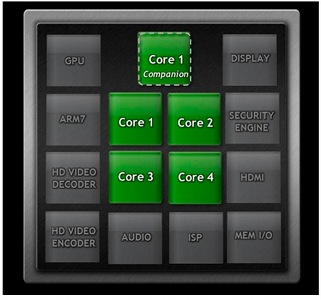
Kal-El's Companion core
Source: Nvidia
(Click to enlarge)
According to Nvidia, the Companion core is designed to execute tasks in "active standby," when a device is not being interacted with by its owner, but is still performing such tasks as email and social media, live wallpapers, active widgets, and more. It also can perform music and video playback, the company adds.
In a Nov. 8 announcement, Nvidia added that the Tegra 3 will also include a new 12-core GeForce GPU (graphics processing unit). This "delivers more realism with dynamic lighting, physical effects and high resolution environments, plus support for 3D stereo," the company said.
Nvidia also released a variety of comparisons with its previous Tegra 2, which also had GeForce graphics but included just two Cortex-A9 cores. The Tegra 3 provides up to five times the CPU performance, three times the GPU performance, and yet uses 61 percent less power, the chipmaker claims.
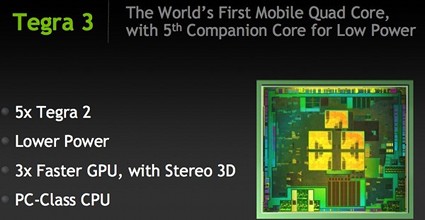
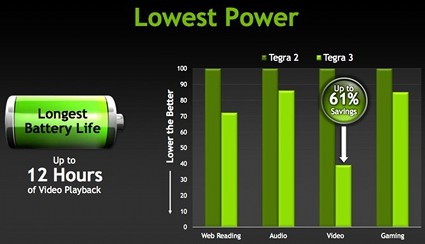
Tegra released slides comparing the Tegra 3's speed (top) and power consumption (bottom) to the Tegra 2
(Click either to enlarge)
In addition, Nvidia provided a massive table comparing Tegra 2 and Tegra 3 specifications. You'll find this toward the end of this story.
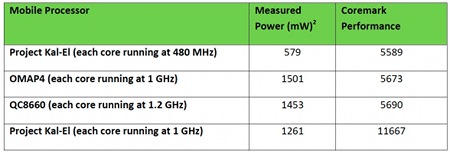
Kal-El power savings compared to competitors
Source: Nvidia
(Click to enlarge)
Previously published figures have compared the Kal-El to TI's dual-core OMAP4 and Qualcomm's 8660. When clocked down to 480MHz, the Kal-El will provide about the same Coremark performance as these competitors, while consuming almost one-third of the power, the company claims. Meanwhile, it's said, a 1GHz clock speed results in nearly twice the Coremark performance of the others, along with lower power consumption than either.
A demonstration of the Tegra 3's companion core
(click to play)
Coming to Android first
As we reported earlier today, the Tegra 3 will be coming first to a 10.1-inch tablet, the Asus Transformer Prime. Expected to arrive in December, the device will sell for $499 with 32GB of flash storage (or $599 for 64GB), and will be offered with the optional keyboard dock ($149) pictured below.
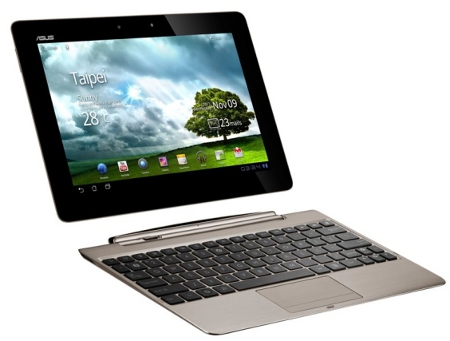
The Asus Eee Pad Transformer Prime and optional keyboard dock
(Click to enlarge)
Nvidia has not said how seamlessly the five Tegra 3 cores might or might not work with the upcoming, ARM-based version of Windows 8, though it did show off a Kal-El tablet running Windows at Microsoft's BUILD conference in September. The chipmaker does say Android 3.x (Honeycomb) has built-in support for multi-processing and is capable of leveraging the performance of multiple CPU cores.
However, Nvidia has noted, Android assumes that all available CPU cores are of equal performance capability, and schedules tasks based on this assumption. Therefore, Kal-El implements both hardware-based and low-level software-based management of its five cores.
| Tegra 2 | Tegra 3 | |
| Processor | ||
| CPU | Dual-Core ARM Cortex A9 | Quad-Core ARM Cortex A9 |
| Max Frequency | Up to 1.2 GHz | Up to Single Core 1.4 GHz /Quad-Core 1.3 GHz |
| L2 Cache | 1 MB | 1 MB |
| L1 Cache (I/D) | (32KB / 32KB) per core | (32KB / 32KB) per core |
| Memory | ||
| Frequency | Up to DDR2-760 Up to LPDDR2-733 |
DDR3-L 1500 LPDDR2-1066 |
| Memory Size | Up to 1GB | Up to 2 GB |
| GPU | ||
| Architecture | ULP GeForce | ULP GeForce |
| Cores | 8 | 12 |
| 3D Stereo | No | Yes |
| Full Programmability | Yes | Yes |
| OpenGL ES Version | 2.0 | 2.0 |
| OpenVG | 1.1 | 1.1 |
| EGL | 1.4 | 1.4 |
| Video (1080p) | ||
| Decode | H.264 VC-1 AP MPEG2 MPEG-4 DivX 4/5 XviD HT H.263 Theora VP8 WMV Sorenson Spark Real Video VP6 |
H.264 (HP @ 40Mbps) VC-1 AP MPEG2 MPEG-4 DivX 4/5 XviD HT H.263 Theora VP8 WMV Sorenson Spark Real Video VP6 |
| Encode | H.264 MPEG4 H.263 VP8 |
H.264 MPEG4 H.263 VP8 |
| Video Teleconference (VTC) | H.264 MPEG4 H.263 VP8 |
H.264 MPEG4 H.263 VP8 |
| Audio | ||
| Decode | AAC-LC AAC+ eAAC+ MP3 MP3 VBR WAV/PCM AMR-NB AMR-WB BSAC MPEG-2 Audio Vorbis WMA 9 WMA Lossless WMA Pro G.729a * G.711 * QCELP * EVRC * * Through third party |
AAC-LC AAC+ eAAC+ MP3 MP3 VBR WAV/PCM AMR-NB AMR-WB BSAC MPEG-2 Audio Vorbis WMA 9 WMA Lossless WMA Pro G.729a * G.711 * QCELP * EVRC * * Through third party |
| Encode | AAC LC AAC+ eAAC+ PCM/WAV AMR-NB AMR-WB |
AAC LC AAC+ eAAC+ PCM/WAV AMR-NB AMR-WB |
| Imaging | ||
| Primary Camera | 12 MP | 32 MP |
| Secondary Camera | 5 MP | 5 MP |
| Mpixel/s | 150 | 300 |
| Digital Zoom | Up to 16x | Up to 16x |
| JPEG Decoding/Encoding | 80MP/sec | 80MP/sec |
| Still Image Stabilitization | Yes | Yes |
| Video Stabilization | Yes | Yes |
| Features | Auto Exposure Auto White Balance Auto Focus Lens Shading 9th order De-Mosaic Sharpening Programmable De-Noise |
Auto Exposure Auto White Balance Auto Focus Lens Shading 9th order De-Mosaic Sharpening Programmable De-Noise |
| MIPI CSI | Yes | Yes |
| Display | ||
| Display Controllers | 2 simultaneous | 2 simultaneous |
| HDMI | 1.3 (1920×1080) | 1.4a (1920×1080) |
| LCD | Up to 1680×1050 | 2048×1536 |
| CRT | Up to 1600×1200 | 1920×1200 |
| MIPI DSI | Yes | Yes |
| Package | ||
| Package | 12×12 PoP 23×23 BGA |
14×14 BGA 23×23 BGA |
| Process | 40 nm | 40 nm |
The Tegra 2 and Tegra 3 compared
Source: Nvidia
Further information
Further information on the Tegra 3 may be found on the Nvidia website via the following links: http://www.nvidia.com/object/tegra-superchip.html, http://www.tegrazone.com, http://developer.nvidia.com/tegra, and http://www.nvidia.com/object/tegra-asus.html.
Jonathan Angel can be reached at [email protected] and followed at www.twitter.com/gadgetsense.
This article was originally published on LinuxDevices.com and has been donated to the open source community by QuinStreet Inc. Please visit LinuxToday.com for up-to-date news and articles about Linux and open source.